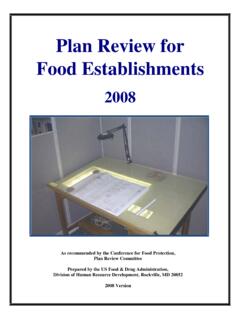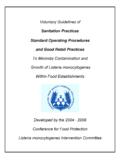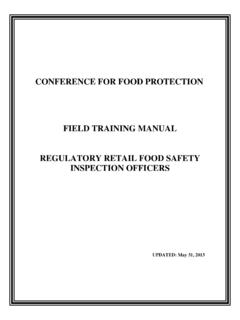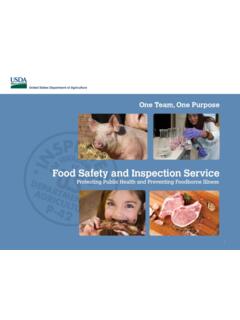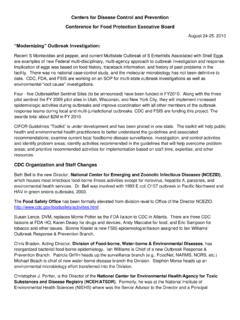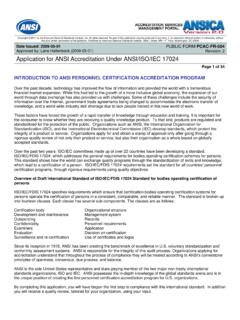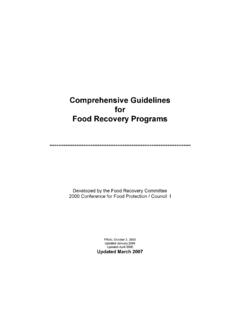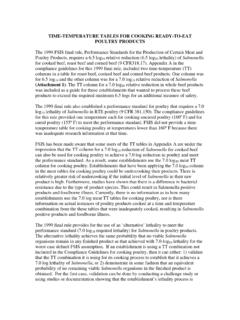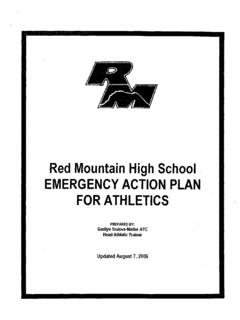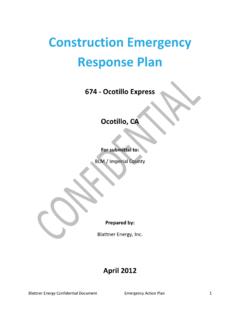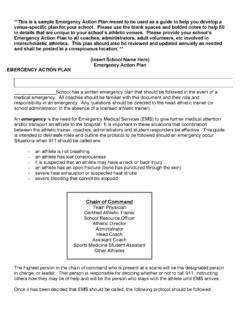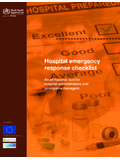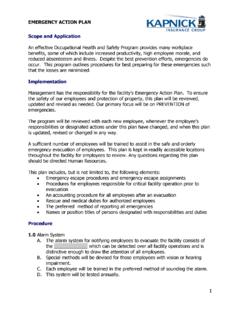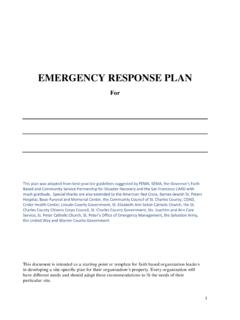Transcription of Emergency Action Plan - Conference for Food Protection
1 2014 Conference for Food Protection - Emergency Action plan for Retail Food Establishments, Second Edition Emergency Action plan for Retail Food Establishments Second Edition Practical guidance for retail grocery and food service establishments to plan and respond to Emergency situations that could impact food safety and facility operations. Original Produced By: Emergency Preparedness Committee of Council II. 2004-2006 Conference for Food Protection First Revision By: Emergency Preparedness and Response Committee of Council II. 2006-2008 Conference for Food Protection Current Edition By: Emergency Action plan Committee of Council III. 2012-2014 Conference for Food Protection Page 1 of 60 1- 22- 14 2014 Conference for Food Protection - Emergency Action plan for Retail Food Establishments, Second Edition Table of Contents Page Disclaimer 3.
2 Preface 4. Introduction 4. Permit Holder Responsibilities and Responding to an Imminent Health Hazard 5. Planning for Response to an Emergency 7. Developing a Written Food Safety Emergency plan 7. Emergency Guidance Interruption of Electrical Service 10. Planning 10. Assessment 12. Business Continuity 12. Time/Temperature Chart for Refrigerated TCS Food During A Power Outage 17. Recovery 21. Interruption of Water Service 23. Planning 23. Assessment 24. Business Continuity 25. Recovery 28. Contaminated Water Supply (Biological) 30. Planning 30. Assessment 30. Business Continuity 30. Recovery 34. Sewage Backup 36. Planning 36. Assessment 37. Business Continuity 38. Recovery 41. Floods 46. Planning 46.
3 Assessment 47. Business Continuity 48. Recovery 49. Fire 55. Planning 55. Assessment 55. Business Continuity 57. Recovery 57. Page 2 of 60 1- 22- 14 2014 Conference for Food Protection - Emergency Action plan for Retail Food Establishments, Second Edition Disclaimer The guidance in this document does not create or confer any rights for or on any person and does not operate to bind public health officials or the public. An alternative approach may be utilized if the approach satisfies the requirements of the applicable statutes and regulations within a government's jurisdiction. Whether this guidance or an alternative procedure is utilized, contact the state or local public health authority responsible prior to implementation.
4 This document includes guidance for several types of emergencies that a food establishment may encounter and is designed as an aid to operators of retail food stores and food service establishments (for example, bakeries, bars, cafeterias, camps, child and adult day care providers, commissaries, convenience stores, grocery stores, interstate conveyances, meal services for home-bound persons, mobile food carts, restaurants, and vending machine operators). This is a diverse set of establishments, which includes both very large and very small entities. During an Emergency or natural disaster it will be critical for individuals to obtain certain necessities such as canned foods, bottled water, batteries, flashlights, coolers, etc.
5 This guidance document is designed to help food establishments know the steps necessary to take to ensure the items they sell will not endanger the public's health. Following a natural disaster there are potential health concerns that can be created by the disruptions caused by the disaster. This publication provides food safety suggestions and information for retail and foodservice establishments continuing to operate or resuming business in the event of natural or other disasters. Persons-in- charge (PICs) of a food establishment should conduct a complete self-inspection to ensure that normal operations can be continued or resumed safely and without compromising food safety. Establishments required to cease operations in an Emergency should not re-open until authorization is granted by the local or state regulatory authority.
6 Other resources, not included here, are available for guidance on handling other emergencies such as those caused by infectious disease agents, tampering and intentional acts of terrorism. Page 3 of 60 1- 22- 14 2014 Conference for Food Protection - Emergency Action plan for Retail Food Establishments, Second Edition Preface This document was created by the 2012 Conference for Food Protection 's Emergency Action plan Committee (EAP). It is replacing the document presented at the 2008. Conference for Food Protection 's biennial meeting entitled Emergency Action plan for Retail Food Establishments. This 2014 version was extensively reformatted and several sections were deleted from the 2008 version. Topics such as intentional contamination and foodborne illness were deleted since these topics are covered extensively in other literature and government resources.
7 This manual is dedicated to events more likely to be caused by nature. This document also has an expanded section which discusses in detail when product may be sold even though it may have been out of temperature control for a limited time frame due to a power outage. Introduction All retail food establishments are vulnerable to a potential Emergency or disaster that could impact the safety of the food and products they sell or serve to consumers. Yet, in times of crises, these facilities can also serve the community and provide valuable resources. Working together, the food industry and regulatory agencies have developed this Guidance to assist in planning for and managing various emergencies. Emergencies are usually unpredicted events that disrupt our lives and businesses.
8 They often develop quickly without prior warning, affecting a limited geographic area, location or population. Emergencies can be both natural and man-made (or more accurately, man-caused ). Examples of emergencies include fire, loss of power or interruption in water service. Disasters are more typically events that have the potential to cause loss of lives, widespread destruction of property, infrastructure disruption, and are often, but not always, preceded by warning notices. Examples of disasters include hurricanes, floods or storms. For purposes of this Guidance, we refer to all events as emergencies even though they may be disasters. Although the type, severity and circumstances of an Emergency will influence decisions regarding food safety, this Guidance provides practical information to help plan for, respond to, and recover from various emergencies.
9 Even though this Emergency Action plan for Retail Food Establishments, Second Edition provides comprehensive information in preparation for and/or involvement in Emergency situations, these documents are not intended to replace pre-existing local, state or federal regulations or procedures. Retail Food Establishments should consider using this Emergency guidance document to compare existing procedures, fill in gaps and update site-specific procedures, create procedures where they don't exist and train staff. Page 4 of 60 1- 22- 14 2014 Conference for Food Protection - Emergency Action plan for Retail Food Establishments, Second Edition Permit Holder Responsibilities and Responding to an Imminent Health Hazard One of the first things that must be done in an Emergency is to determine if there is an imminent health hazard.
10 According to the FDA Food Code definition: "Imminent health hazard" means a significant threat or danger to health that is considered to exist when there is evidence sufficient to show that a product, practice, circumstance, or event creates a situation that requires immediate correction or cessation of operation to prevent injury based on: (1) The number of potential injuries, and (2) The nature, severity, and duration of the anticipated injury. Further, the Food Code states: Ceasing Operations and Reporting. (A) Except as specified in (B) of this section, a PERMIT HOLDER shall immediately discontinue operations and notify the REGULATORY AUTHORITY if an IMMINENT HEALTH HAZARD may exist because of an Emergency such as a fire, flood, extended interruption of electrical or water service, SEWAGE backup, misuse of POISONOUS OR TOXIC MATERIALS, onset of an apparent foodborne illness outbreak, gross insanitary occurrence or condition, or other circumstance that may endanger public health.
